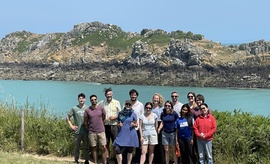Calculation of the force field required for nucleus deformation during cell migration through constrictions
During cell migration in confinement, the nucleus has to deform for a cell to pass through small constrictions. Such nuclear deformations require significant forces. A direct experimental measure of the deformation force field is extremely challenging. However, experimental images of nuclear shape are relatively easy to obtain. Therefore, here we present a method to calculate predictions of the deformation force field based purely on analysis of experimental images of nuclei before and after deformation. Such an inverse calculation is technically non-trivial and relies on a mechanical model for the nucleus. Here we compare two simple continuum elastic models of a cell nucleus undergoing deformation. In the first, we treat the nucleus as a homogeneous elastic solid and, in the second, as an elastic shell. For each of these models we calculate the force field required to produce the deformation given by experimental images of nuclei in dendritic cells migrating in microchannels with constrictions of controlled dimensions. These microfabricated channels provide a simplified confined environment mimicking that experienced by cells in tissues. Our calculations predict the forces felt by a deforming nucleus as a migrating cell encounters a constriction. Since a direct experimental measure of the deformation force field is very challenging and has not yet been achieved, our numerical approaches can make important predictions motivating further experiments, even though all the parameters are not yet available. We demonstrate the power of our method by showing how it predicts lateral forces corresponding to actin polymerisation around the nucleus, providing evidence for actin generated forces squeezing the sides of the nucleus as it enters a constriction. In addition, the algorithm we have developed could be adapted to analyse experimental images of deformation in other situations.


